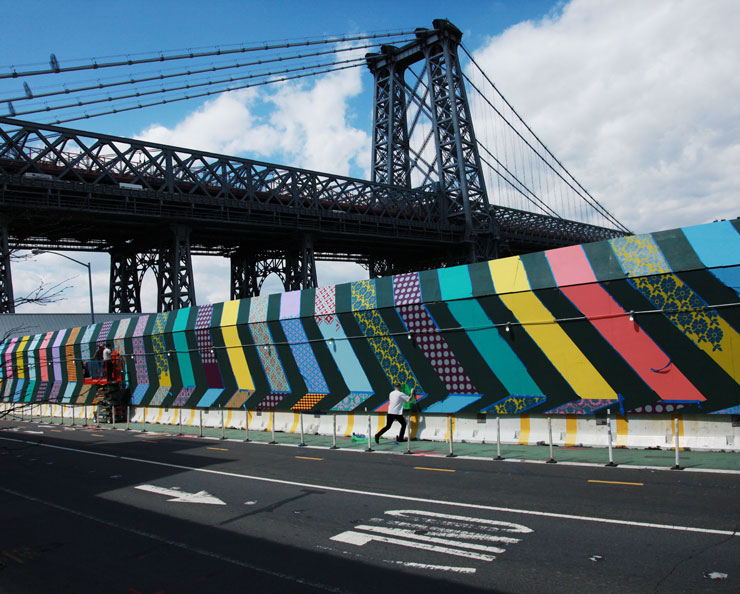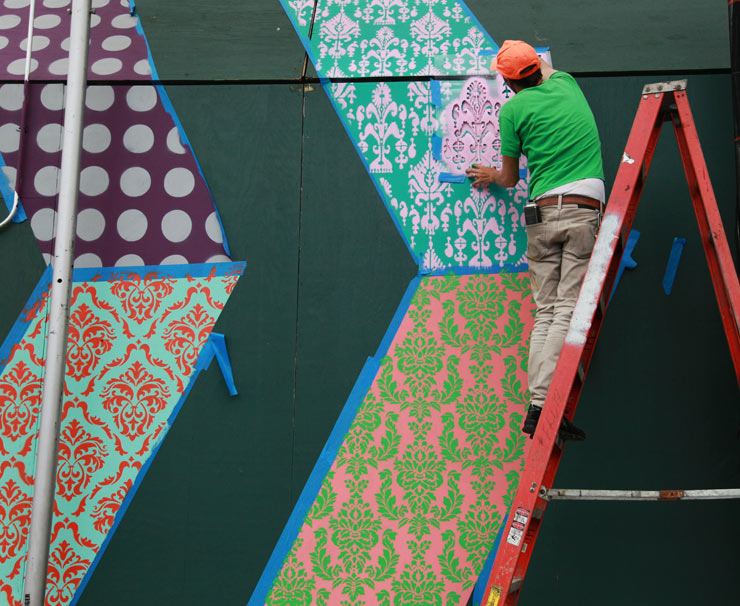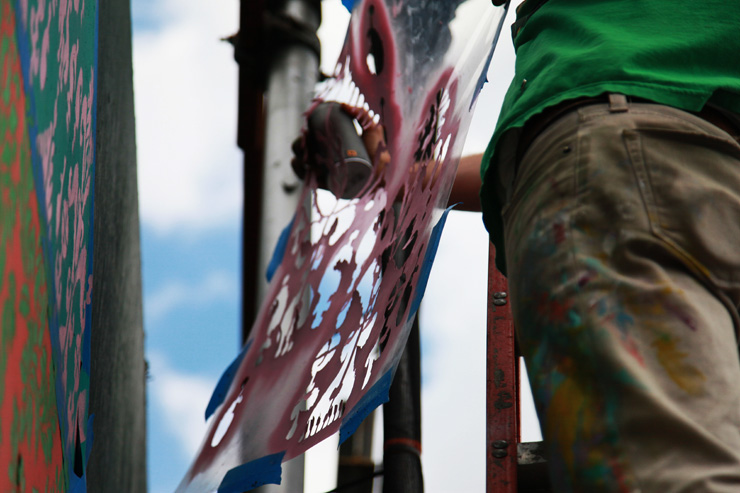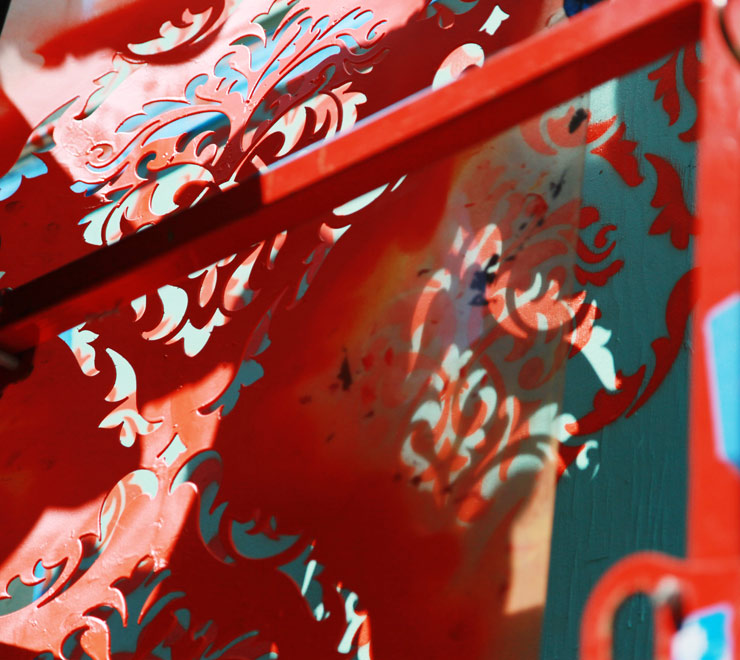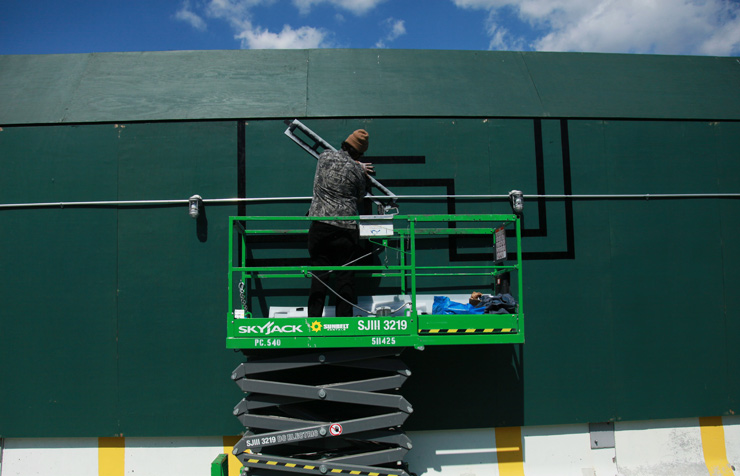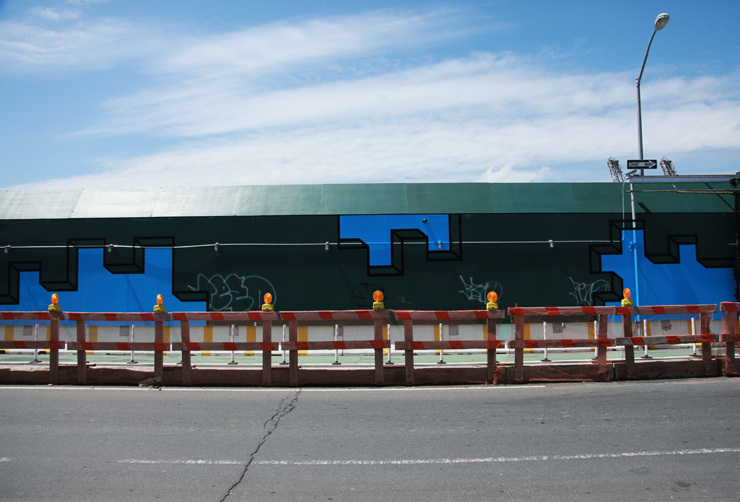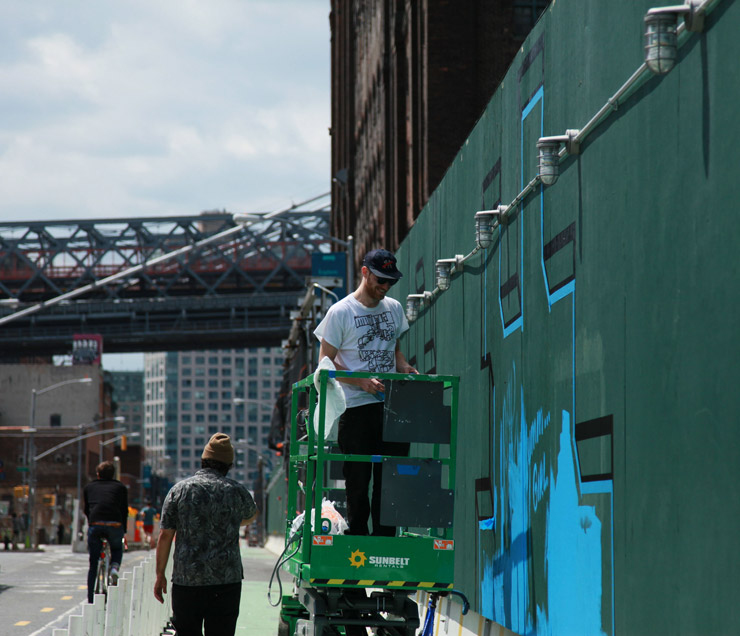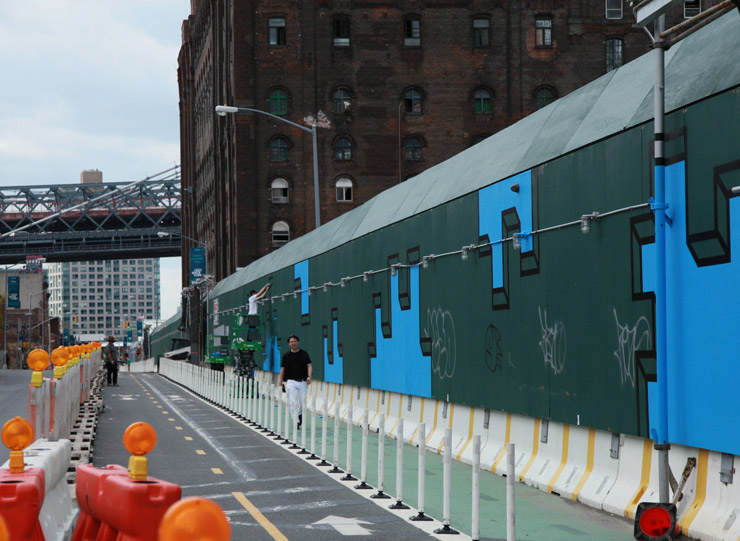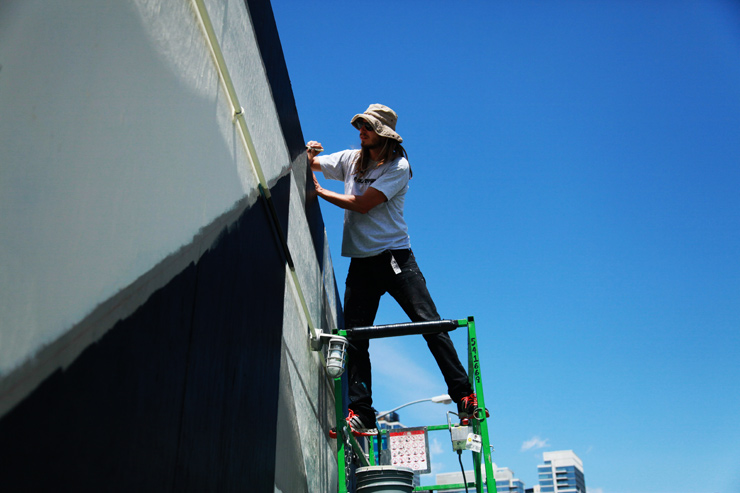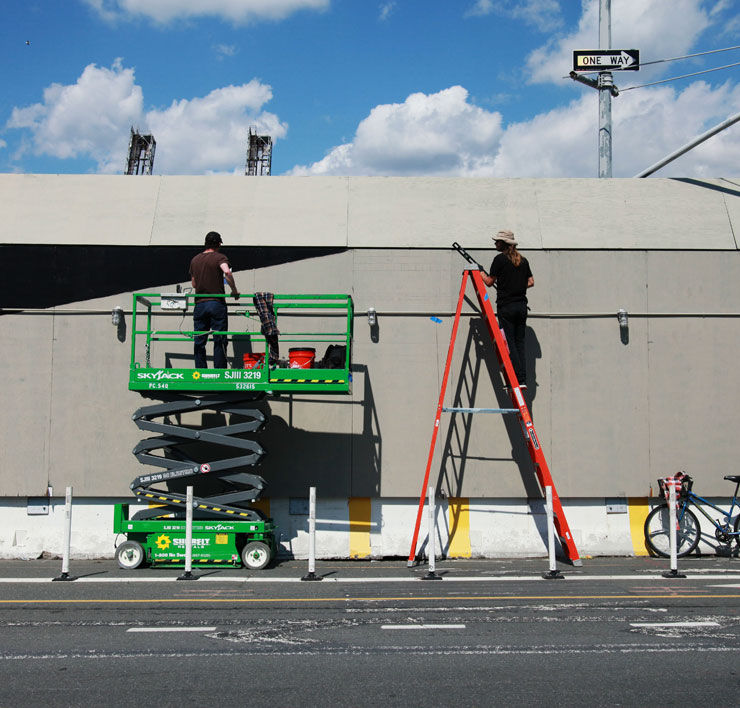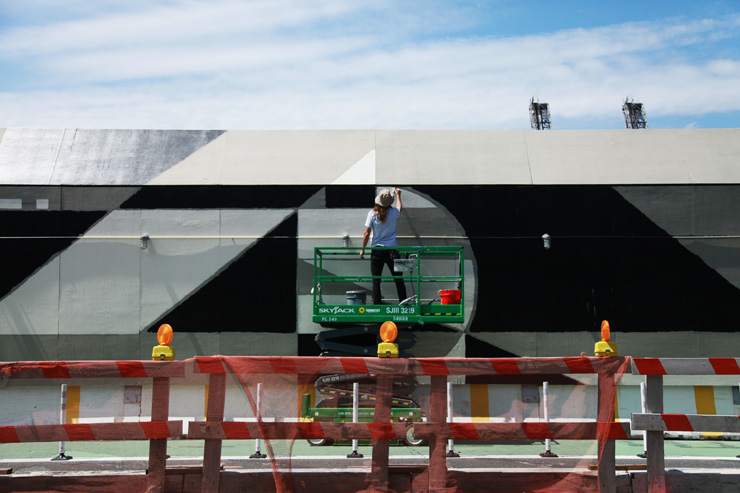Williamsburg once ran heavy with renegade Street Art; names like Faile, Swoon, Bast, Shepard Fairey, Gaia, NohJColey, Judith Supine, Momo, Elbowtoe, Dain, DarkClouds, Matt Siren, Armsrock, Dennis McNett… well you get the point. Add about 40 more names and you can begin to re-construct the explosion that happened here mostly because industry had died and artists in the 80s and 90s and early 00s flocked to the previously industrial maritime neighborhood for space to create art, mount exhibitions, and have lots of free sex. Just checking to see if you were paying attention.
Hellbent at work on his portion of the wall. (photo © Jaime Rojo)
Now almost 10 years into a North Brooklyn rezoning and construction boom (with a small break for the Great Recession) some of those same street artists are actually invited to paint walls in the same neighborhood – by landlords, advertisers, developers, and businesses. The Domino Sugar Factory, long an employer and symbol of industry on the river is now beginning a humungous decade-long renovation with new buildings planned while retaining the old refinery building on the site. Before buildings started coming down last summer these mammoth green construction walls went up, creating this sort of municipal/industrial sealed green monotony for five blocks on Kent Avenue.
Hellbent at work on his portion of the wall. (photo © Jaime Rojo)
Today Hellbent, Rubin, and Aakash Nihalani, three artists who have been doing work in the streets for much of this time (and who have each made inroads into the gallery system), are each taking on their largest projects ever and culling more friends and buckets and cans and courage than ever to knock out these prodigious paintings. We’re calling it “Domino Walls” because we’re clever at naming things and we’re acting as “curatorial advisors” because hey, that’s what we do. BSA has a history of working with community and arts institutions, small and large, to give a variety of street artists a voice and to introduce them to greater audiences. This project provides a showcase to some of the strong voices who are familiar with working on the streets and who are pushing that language in new directions.
Hellbent. Process shot. (photo © Jaime Rojo)
A lot of urban art academics and critics have been talking about this new hybrid of art on the street that is sometimes called ‘graffuturism’ and we are very gratified to present a few of the new practitioners on the street who reflect it. Employing geometric shapes, deconstruction, abstraction, minimalism, even Op Art techniques, this quickly shifting movement unites graffiti, street art, and contemporary; at once futuristic while paying tribute to art movements more than a hundred years old. With MOMA’s “Inventing Abstraction” show last year and the Guggenheim’s “Italian Futurists” show right now, we feel like our 2012 show “Geometricks” right here in Brooklyn was actually just ahead of the curve. Putting Hellbent, Aakash, and Rubin together on massive walls in Williamsburg feels like this is right on time for this decade.
So we’ll tell you more about the project and each artist a little later but we wanted to show you the progress thus far so you know what is going on on these giant walls. If you are planning to see the astounding Kara Walker show that opens this week on the site and features more sugar than you can consume during a month of Halloweens – you’ll also definitely be seeing some rockin’ eye candy in progress right on the street here as well.
Hellbent. Detail of one of the stencils. (photo © Jaime Rojo)
“We all work in different ways but in a similar abstract nature and that is kind of why we are here together. It shows a little of the arc of abstraction and the different sort of forms you can go with. We’re all pretty geometric at the same time – using the power of the clean line and using optical tricks,” says Hellbent as he and his team are on their 9th day knocking out a nearly 500 foot long piece called We Walk (REM).
“I like the way Jaime (Rojo) described this wall when he said I was changing the shape of the wall through color and pattern and repetitions and that the visual effect pushes you forward. I think that more or less describes the movement for me at this moment and it is what I have been doing.”
Aakash Nihalani at work on his portion of the wall. (photo © Jaime Rojo)
Aakash doesn’t typically work with paint and stencils, preferring his trademark bright masking tape method of revealing geometry in public spaces but he is going huge here for his piece tentatively titled Spaced. “I don’t have a lot of roots in graffiti, I mean, we share the same territory and spaces. But I don’t liken myself to a graffiti artist per se. I mean it does make sense that after a certain amount of time in a period of an art movement that it is bound to start deconstructing and abstracting, concentrating more on the form instead of the content. So I guess that kind of makes sense and I guess my work sort of fits in with that evolution, so its definitely part of that, but it is not intentional.”
Askash Nihalani letting the sky bust through on this work in progress. (photo © Jaime Rojo)
Aakash and his assistant at work on the wall. (photo © Jaime Rojo)
Aakash Nihalani. Process shot. (photo © Jaime Rojo)
Rubin at work on his portion of the wall. (photo © Jaime Rojo)
One of the most active graffiti writers in Sweden in the 1990s, Rubin has been deconstructing his earlier work and uncovering his Finnish/Swedish DNA. For his block long Resistance V. Acceptance, he says “I’m busy looking forward – I’m very much influenced by the Futurist movement , the Bauhaus. It’s also really natural for me growing up in Scandinavia – I grew up with the streamline and the IKEA – so it is like a parallel with the minimalism of Scandinavia so when I discovered the whole Futurist movement it made perfect sense,” he explains.
“Moving to working more large scale I had to adapt my work so that I can still work fast. It suits me so well. It is also is about balance – it can’t be too geometric so its’ always a struggle so that is why I try to keep my work free hand – so I don’t use projectors and stencils. I started using the chalk line more because it’s a time saver, but also I try to keep it analog and organic and physical. It can’t be too sharp – there has to be a more human element”
Rubin and one of his assistants at work on the wall. (photo © Jaime Rojo)
Rubin process shot. (photo © Jaime Rojo)
Rubin’s detail of his sketch for the project. (photo © Jaime Rojo)
Read Part II of this project here:
“Done!” Murals from Rubin, Aakash, & Hellbent : Domino Walls Part II
<<>>><><<>BSA<<>>><<<>><><BSA<<>>><><<>BSA<<>>><<<>><><
BSAPlease note: All content including images and text are © BrooklynStreetArt.com, unless otherwise noted. We like sharing BSA content for non-commercial purposes as long as you credit the photographer(s) and BSA, include a link to the original article URL and do not remove the photographer’s name from the .jpg file. Otherwise, please refrain from re-posting. Thanks!
<<>>><><<>BSA<<>>><<<>><><BSA<<>>><><<>BSA<<>>><<<>><><BSA
Other Articles You May Like from BSA:
You’ll Need Good Shoes. That’s what most people will tell you in the Wynwood District of Miami if you want to see everything, especially now that the murals go further north up the grid. Tatiana S...
Happy Holidays! We’re celebrating the end of one year and the beginning of the next by thanking BSA readers, friends, and family for all of your support in 2022. We have selected some of our favo...
Today at the invitation of Christie's Education we'll be participating in a panel discussion about Street Art and how it is being embraced by the art market, museums, and galleries. We're honored to s...
Today's special guest: Never Crew, (Christian Rebecchi and Pablo Togni), Swiss Street Art duo, environmentalists, neo-realist naturalists, mural interventionists We love this picture because in a simp...
A roundup today for the Nuart street art/ mural festival in Norway with images of the final walls by this years artists. Now celebrating its 15th year, the mid-sized fjord-facing city of Stavanger has...
 BROOKLYN STREET ART LOVES YOU MORE EVERY DAY
BROOKLYN STREET ART LOVES YOU MORE EVERY DAY